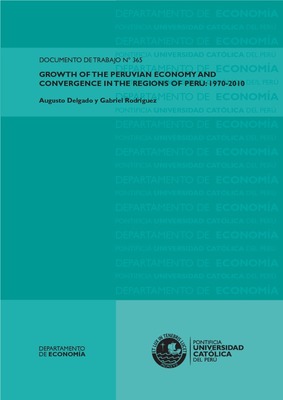| dc.contributor.author | Delgado, Augusto | |
| dc.contributor.author | Rodríguez, Gabriel | |
| dc.date.accessioned | 2015-03-19T20:37:56Z | |
| dc.date.available | 2015-03-19T20:37:56Z | |
| dc.date.issued | 2013 | |
| dc.identifier.uri | http://repositorio.pucp.edu.pe/index/handle/123456789/47005 | |
| dc.description.abstract | La economía peruana ha crecido sosteniblemente durante los últimos 15 años. Verificar si los departamentos (o regiones) han logrado un proceso de convergencia, ya sea hacia un único estado estacionario o su propio estado estacionario, sería equivalente a la verificación de un proceso de inclusión en dicho proceso de crecimiento. Características básicas del censo nacional nos permiten afirmar que un gran número de los departamentos que aún no llegan a ciertos criterios mínimos de subsistencia son, por tanto, en un claro proceso de exclusión. Desde esta perspectiva, consideramos que el concepto de convergencia nos puede dar un poco de luz sobre la situación. Si existe convergencia, es probable que dicha convergencia se realiza hacia la pobreza o la exclusión. En este documento, diferentes pruebas estadísticas se aplican para verificar la existencia de convergencia estocástica y determinística, así como una metodología reciente para la identificación de los denominados clubes de convergencia. Los resultados de la aplicación de las pruebas de raíz unitaria sin cambio estructural indican la inexistencia de convergencia estocástica. Sin embargo, al incorporar la presencia de ruptura endógena los resultados se invierten para todos los departamentos, con excepción de Huancavelica. La aplicación de un estadístico de quiebre estructural robusto a la presencia de errores de tipo I(0) e I(1) nos permite estimar las tasas departamentales de crecimiento antes y después del punto de quiebre identificado endógenamente. Los resultados sugieren que la mayoría de los Departamentos han acelerado sus tasas de crecimiento luego del punto de ruptura. Algunos departamentos muestran la inexistencia de cambios estructurales e incluso algunos casos muestran una desaceleración de sus tasas de crecimiento. Por otro lado, se ha encontrado evidencia acerca de la formación de clubes de convergencia que son robustos a diferentes tipos de ordenamiento sugeridos en la metodología . De acuerdo con esta metodología, los departamentos de Apurímac y Huancavelica no forman parte de ningún club de la convergencia, lo que significa que no están conectadas con el resto del país. | es_ES |
| dc.description.abstract | The Peruvian economy has been growing sustainably during the last 15 years. Verifying whether the Departments (or Regions) have achieved a process of convergence, be it towards a single stationary state or its own stationary state, would be equivalent to verifying a process of inclusion in the said process of growth. Basic characteristics of the national Census allow us to state that a great number of the Departments that still do not reach certain minimum criteria of subsistence are therefore in a clear process of exclusion. From this perspective, we think that the concept of convergence can give us some light over the situation. If convergence exists, it is probable that the said convergence is realized towards poverty or exclusion. In this document, different statistical tests are applied to verify the existence of stochastic and deterministic convergence, as well as a recent methodology for identifying the so-called clubs of convergence. The results of the application of the tests of unit root without structural break indicate the inexistence of stochastic convergence. However, when incorporating the presence of endogenous break the results get reversed for all the Departments with the exception of Huancavelica. The application of a statistic for structural break robust to the presence of errors of type I(0) and I(1) allow us to estimate the departamental rates of growth before and after the break. The results suggest that the majority of the Departments have accelerated their rates of growth after the breaking point. Some Departments show the inexistence of structural change and even a few cases show a deceleration of their rates of growth. On the other hand, evidence has been found about the formation of clubs of convergence that are robust to different order settings proposed by the methodology that was utilized. According to that methodology, the Departments of Apurimac and Huancavelica are not part of any club of convergence, which means that they are disconnected to the rest of the country. | en_US |
| dc.language.iso | spa | es_ES |
| dc.publisher | Pontificia Universidad Católica del Perú. Departamento de Economía | es_ES |
| dc.relation.ispartof | urn:issn:2079-8466 | |
| dc.relation.ispartof | urn:issn:2079-8474 | |
| dc.relation.ispartofseries | Documento de Trabajo;365 | es_ES |
| dc.rights | info:eu-repo/semantics/openAccess | es_ES |
| dc.rights.uri | http://creativecommons.org/licenses/by-nc-nd/2.5/pe/ | * |
| dc.subject | Crecimiento económico--Perú--1970-2010 | es_ES |
| dc.title | Growth of the peruvian economy and convergence in the regions of Perú: 1970-2010 | es_ES |
| dc.title.alternative | El crecimiento de la economía peruana y la convergencia en las regiones del Peru: 1970-2010. | es_ES |
| dc.type | info:eu-repo/semantics/workingPaper | |
| dc.type.other | Documento de trabajo | |
| dc.subject.ocde | http://purl.org/pe-repo/ocde/ford#5.02.00 | |
| dc.publisher.country | PE | |
| renati.advisor.orcid | https://orcid.org/0000-0003-1174-9642 | |


